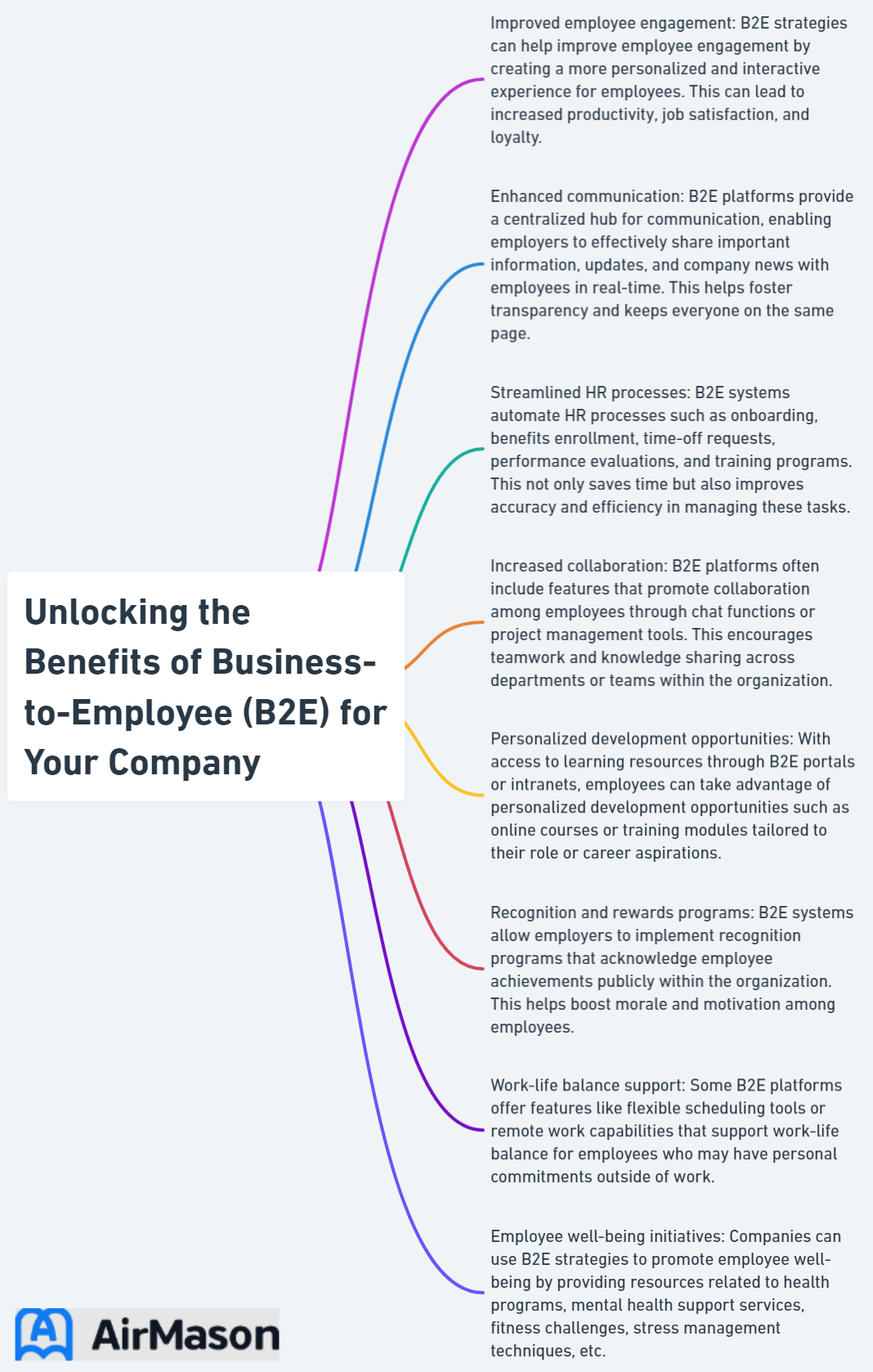
Imagine a workplace where employees feel empowered, engaged, and motivated to perform at their best. This vision can become a reality by harnessing the power of Business-to-Employee (B2E) strategies. B2E goes beyond just attracting and retaining talent; it focuses on improving the digital workplace and overall employee experience through personalized tools and strategies. Let’s explore the world of B2E and unlock its benefits for your company.
Key Takeaways
- B2E involves providing products and services to employees, utilizing marketing strategies for positive employee experience, and increasing company value.
- Employee experience is essential for success in B2E, requiring personalized portals, multi-channel communication & campaign-based strategies.
- Collaboration between HR & Marketing departments is key to successful implementation of initiatives with measurable goals and KPIs.
Employee Definition
The “employee definition” is a crucial concept within the realm of workforce management. In essence, the term refers to the formal identification and categorization of individuals engaged in a working relationship with an organization. This designation encompasses various factors, including the nature of employment, contractual obligations, and the rights and responsibilities of both the employer and the employee. Understanding the “employee definition” is pivotal for legal and regulatory compliance, as it sets the parameters for issues such as taxation, benefits eligibility, and labor laws. Furthermore, organizations often refine their internal policies based on the nuances of the “employee definition,” shaping the dynamics of the employer-employee relationship within the organizational framework.
Understanding B2E: More Than Just a Buzzword
B2E, or Business to Employee B2E, allows a business to provide products and services to its employees through an intrabusiness network. This form of electronic commerce offers organizations greater flexibility in providing goods and services to their staff, while also facilitating business to business and business to consumer interactions. This enterprise strategy includes:
- Attracting, recruiting, training, onboarding and retaining employees
- Providing self-service solutions and individualized access to required tools or software
- Prioritizing the interests of employees, who are the end users of these digital tools
- Aiming to improve their daily experiences within the digital workplace.
Online businesses often grapple with the challenge of employee satisfaction. Adopting a marketing mindset in B2E can help provide a positive experience for internal personnel, mirroring strategies used in B2B and B2C marketing. A comprehensive B2E program will yield positive results in terms of maintaining your most valued audience – the individuals who drive your business, just like in B2C marketing.
Providing a positive customer experience for employees fosters company loyalty, considering they are also internal consumers of the company’s resources and services. Fostering engaged employees can contribute to upholding high levels of customer satisfaction, bolstering your organization’s reputation, and increasing the company’s overall value for your stakeholders. For example, companies like Southwest Airlines and Starbucks have successfully implemented B2E initiatives to improve employee engagement and satisfaction.

The Power of Employee Experience in B2E
In B2E, the employee experience plays a pivotal role because it directly influences productivity, satisfaction, and brand loyalty. A high rate of employee turnover can be costly and damage a company’s reputation. It can also reduce morale and impede operations. B2E initiatives strive to establish a positive and engaging work environment, ensuring that employees feel valued and supported in their roles.
Deloitte’s 2017 Global Human Capital Trends Survey indicated that approximately 80 percent of business leaders and HR managers deemed employee experience as either “important” or “very important”, yet only 22 percent of respondents rated their companies as “excellent” in constructing such an experience for their personnel. This highlights the need for organizations to invest in B2E strategies that prioritize employee experience.
The employee experience encompasses not only the retention of employees but also their attraction. Companies should endeavor to maximize employee retention by utilizing successful web strategies and assembling a successful e-commerce team. Giving priority to employees turns them into brand ambassadors, driving the success of the business as a whole.
Essential Components of B2E Marketing
A well-rounded B2E marketing strategy involves creating personalized employee portals, utilizing multi-channel communication, and implementing campaign-based strategies to ensure long-term success.
We’ll explore these components further to comprehend their significance in B2E marketing.
Employee Portals: A Personalized Approach
A B2E portal is a centralized platform that facilitates employees’ access to corporate-related information and resources. Unlike intranets, which cater to the requirements of an organization as a whole, B2E portals prioritize individual needs and can be tailored to each user. This fosters a sense of community within the organization and boosts both efficiency and employee satisfaction.
B2E portals facilitate the distribution of corporate data and showcase advantages, programs, and total rewards in a single centralized location. Offering customization and personalization, employee portals meet the unique needs of each individual, guaranteeing access to necessary information and resources for their roles.
Moreover, employee portals can help attract and retain top talent by providing a seamless user experience that demonstrates the company’s commitment to employee satisfaction and well-being. As a result, employees feel valued and understood, leading to increased engagement and loyalty towards the organization.
Multi-Channel Communication for Maximum Engagement
Multi-channel communication in B2E marketing refers to the utilization of multiple channels to deliver information and facilitate communication with employees. This approach allows employees to access information and communicate in a manner that meets their individual preferences and requirements.
Multi-channel communication serves to enhance engagement and streamline communication between employees. It provides employees with the opportunity to exchange knowledge, access information, and work together through various channels, including phone, email, text, and mobile applications.
A successful multi-channel communication strategy in B2E marketing necessitates:
- Consistency and quality of communication
- Leveraging various communication channels such as social media, search engines, email, and text messages
- Providing pertinent and valuable content that resonates with the target audience’s needs and interests.
Maintaining consistent messaging and engagement across various platforms significantly enhances the effectiveness of B2E initiatives.
Campaign-Based Strategies for Long-Term Success

Campaign-based strategies can be highly effective in maintaining momentum and driving long-term success in B2E marketing efforts. Employees can be encouraged to take immediate action and gain knowledge about several programs and services when utilizing a campaign-based approach. To create an effective B2E marketing campaign, it is important to:
- Understand your employees
- Build long-term relationships
- Offer rational reasons
- Make the content relevant and inspiring
- Invest appropriately
Effective communication and understanding the needs of your employees are key to a successful B2E marketing campaign, ensuring a positive consumer experience.
Components of a successful B2E marketing campaign include:
- Mission statement
- Company branding
- 12-month business goals and challenges
- Target customers
- Customer personas
- Competitive research
- Budget allocation
- Content creation and distribution
- Visuals and design elements
- Measurement and analytics
Integrating these elements can help organizations guarantee the long-term success of their B2E initiatives.
B2E in Action: Real-Life Examples and Use Cases

Real-life examples of B2E initiatives include e-commerce sales teams benefiting from streamlined processes and easy access to information, leading to increased efficiency and satisfaction. Companies such as Sephora, Southwest Airlines, and Starbucks have successfully implemented B2E initiatives to improve employee engagement and satisfaction.
Sephora, for example, uses technology to improve the company’s employee experience and provide training and development opportunities. Southwest Airlines prioritizes the in-flight experience and invests in employee training and development. Starbucks focuses on empowering their employees and providing growth opportunities.
These real-life examples demonstrate the potential impact of B2E strategies on employee experience and satisfaction. By implementing B2E initiatives, organizations can enhance employee engagement, productivity, and loyalty, ultimately contributing to the overall success of the business.
Collaboration is Key: Aligning HR and Marketing Efforts

A cohesive B2E strategy requires the alignment of HR and marketing efforts, which ensures collaboration between both departments to create a positive employee experience. By collaborating with the Chief Marketing Officer (CMO), tangible outcomes can be achieved, facilitating change management and ensuring that messages, objectives, and company vision are all in alignment.
Integrating HR and marketing initiatives in a B2E strategy can offer numerous advantages, such as:
- Increasing employee satisfaction and productivity
- Drawing and preserving highly skilled personnel
- Augmenting employee involvement
- Harmonizing employees with business objectives
- Enhancing internal communication.
Through collaboration and alignment between HR and marketing departments, organizations can maximize the effectiveness of their B2E initiatives, fostering a positive and engaging work environment for all employees.
Function of Employee
The function of employees within an organization is pivotal to its success. The “function of employee” encompasses a range of responsibilities and tasks that contribute directly to the achievement of organizational goals. From daily operational duties to collaborative project work, understanding and fulfilling the function of employees ensures the seamless integration of individual efforts into the broader framework of the company’s objectives. Effectively aligning with the function of employees requires clear communication, defined roles, and a supportive work environment, fostering a culture where each employee’s functions harmonize to drive collective success.
Measuring the Impact of B2E Initiatives
To understand their effectiveness and make data-driven decisions to enhance employee experience and satisfaction, it’s imperative to measure the impact of B2E initiatives. To effectively assess the impact of B2E initiatives, it is recommended to:
- Set clear and measurable goals
- Define specific metrics and KPIs
- Collect feedback
- Conduct assessments
- Utilize data analytics
- Compare to a baseline
- Measure impact on the bottom line
- Apply evaluation frameworks such as the Kirkpatrick Model or ROI Model.
The success of employee portals as a B2E initiative can be monitored through various methods, including:
- Employee feedback and engagement
- Usage analytics
- Performance indicators
- Integration with other systems
- Surveys and assessments
By continuously evaluating the effectiveness of B2E initiatives, organizations can make informed decisions and adjustments to enhance the overall employee experience.
Assessing the long-term success of campaign-based B2E strategies requires the following steps:
- Establishing a timeline for the campaign
- Harmonizing the objectives with available metrics
- Monitoring and analyzing various metrics
- Analyzing customer lifetime value (CLV)
- Regularly refining strategies based on insights gained from the metrics
By measuring the impact of B2E initiatives, organizations can ensure the continuous improvement and success of their employee experience efforts.
Overcoming B2E Challenges: Tips for Success
Addressing B2E challenges requires employee engagement in the creation of B2E portals, consistent communication, and ongoing evaluation and improvement of B2E strategies. Some common challenges associated with B2E implementation include insecurity and fear of loss among employees, lack of visibility of skills at the organizational level, resistance to change and misalignment, inadequate communication and accountability, technical proficiency necessary to perform the job, and cultural and developmental issues within the organization.
To maximize employee engagement in the development of B2E portals, companies should prioritize creating a compelling user experience, personalizing content, and providing incentives for participation. Additionally, ensuring consistent communication across various channels, such as email, text, and social media, is crucial for keeping employees informed and engaged.
Regularly evaluating and refining B2E strategies based on employee feedback and performance data can help organizations address and overcome these challenges, ultimately leading to a more engaged and satisfied workforce.
Summary
Throughout this blog post, we have explored the power of B2E strategies in enhancing employee experience, satisfaction, and loyalty. By implementing personalized employee portals, multi-channel communication, and campaign-based strategies, organizations can create a positive and engaging work environment that empowers employees to excel in their roles.
As we’ve seen, collaboration between HR and marketing departments is crucial for a cohesive B2E strategy, ensuring that both departments work together to achieve common goals. Through continuous evaluation and improvement of B2E initiatives, organizations can overcome challenges and drive the long-term success of their employee experience efforts, ultimately contributing to the overall success of the business.
Understanding the Distinction: An Employee or a Employee
When considering the hiring process, it’s crucial to recognize the grammatical distinction between “an employee or a employee” The choice between “an” and “a” depends on the following word’s initial sound. In English, “an” is used before words that begin with a vowel sound, while “a” is used before words that begin with a consonant sound. This linguistic nuance may seem subtle, but it holds significance in conveying professionalism and language accuracy within the workplace. Employers should emphasize the importance of proper grammar to ensure effective communication and uphold a high standard of written and verbal expression among their workforce.
Frequently Asked Questions
What is an example of a B2E business to employee?
Business-to-employee (B2E) electronic commerce is a type of intrabusiness network that allows companies to provide products and services to their employees. An example of this would be online insurance policy management.
What is the difference between B2B and B2E?
B2B (Business to Business) e-commerce focuses on online sales between businesses, while B2C (Business to Consumer) focuses on online sales to consumers. B2E (Business to Employee) is more focused on employee satisfaction and retention rather than sales.
Why is B2E important?
B2E is an important strategy that businesses use to provide a memorable employee experience and improve their overall success. It covers everything from promoting the company’s mission and values to recruiting, onboarding, training, and retaining employees, all with the aim of making the company an attractive and desirable place to work.
Can I give my business to my employees?
You can give your business to your employees through an ESOP which allows a gradual and seamless transition. Your employees will benefit from the ownership structure and continue working with little change.
What is B2E?
B2E stands for Business-to-Employee, a form of electronic commerce that facilitates the supply of products and services to employees within an organization.